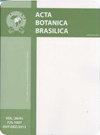巴西查科保护区和受干扰地区草本-亚灌木群落木本植物去除效果
IF 1.1
4区 生物学
Q4 PLANT SCIENCES
引用次数: 0
摘要
查科地区木本植物的消失对植物群落的影响,以及对草本植物组成和功能结构的影响尚不清楚。因此,本研究旨在评估人类活动对查科保护区和受干扰地区草本-亚灌木群落的影响。具体而言,我们研究了巴西查科8个地区物种多样性、组成和生命形式比例的异同。样本取自位于受干扰和保护区的800个1x1m²样地的草本-亚灌木群落。在记录的130种中,有46种是受干扰地区特有的。物种组成在保护区和受干扰地区之间存在差异(PERMANOVA;P = 0.001)。PCoA排序分析表明,受干扰地区的样地聚集度高于保护区。在保护区内,指示种分析显示,半隐种是最具代表性的生命形式。在受干扰地区,指示物种中生命形式的比例为半隐型,其次是热生型和变色型。我们的研究表明,在草本-亚灌木群落中,物种组成、结构和多样性以及指示物种组发生了变化。树木和灌木的移除导致了查科环境中这一组成部分的新配置。本文章由计算机程序翻译,如有差异,请以英文原文为准。
Effect of woody plant removal in herb-subshrub communities in preserved and disturbed Brazilian Chaco areas
The impacts caused on Chaco plant communities by the removal of woody species, together with the effects on the composition and functional structure of herbaceous plants, are still unknown. Therefore, this study aimed to assess the effects of anthropization on herb-subshrub communities in preserved and disturbed Chaco areas. Specifically, we examined differences and similarities in species diversity, composition and proportion of life forms in eight areas of Brazilian Chaco. Samples were taken from herb-subshrub communities using 800 1x1m² plots located in disturbed and preserved areas. Among 130 recorded species, 46 were exclusive to disturbed areas. The composition of species differed between preserved and disturbed areas (PERMANOVA; p = 0.001). PCoA ordination analysis showed greater aggregation of the plots in disturbed areas than in preserved areas. In preserved areas, an analysis of indicator species showed Hemicryptophytes species as the most representative life form. In disturbed areas, the proportion of life forms among indicator species was Hemicryptophytes, followed by Therophytes and Chamaephytes. Our study shows evidence that alterations in species composition, structure, and diversity, as well as sets of indicator species, occur in herb-subshrub communities. The removal of trees and bushes leads to a new configuration of this component in Chaco environments.
求助全文
通过发布文献求助,成功后即可免费获取论文全文。
去求助
来源期刊

Acta Botanica Brasilica
PLANT SCIENCES-
CiteScore
2.30
自引率
9.10%
发文量
32
审稿时长
6-12 weeks
期刊介绍:
Experimental, theoretical and applied papers on all aspects of plant (including algae) and fungi biology are welcome. The submitted manuscript or its essential content must not have been published previously or be under consideration for publication elsewhere. Contributions should be substantial, written in high-quality English and show general interest. We expect that the submitted manuscript presents a great novelty in Botany, and this should attract a wide audience. Considering this, case studies are only considered if the narrative and implications are provided to be of general interest. Thus, manuscripts that report aspects of local interest are discouraged unless the implications of the findings are wide-reaching. Manuscripts with agronomic subjects are expected to contain a substantial amount of basic plant biology. Please see below some details for specific area.
 求助内容:
求助内容: 应助结果提醒方式:
应助结果提醒方式:


